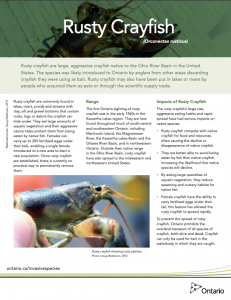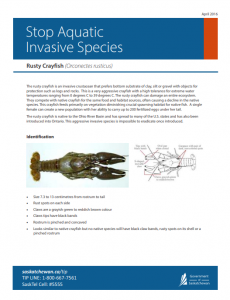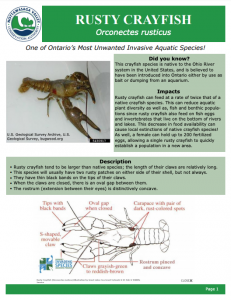Rusty Crayfish (Orconectes rusticus)
French common name: Écrevisse américaine
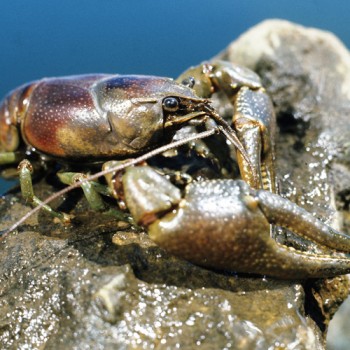
Rusty crayfish look similar to native crayfish but are distinguishable by the oval space between their closed claws.
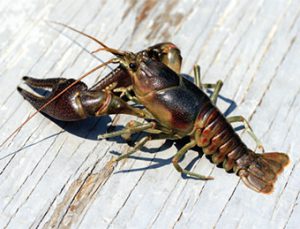
Rusty crayfish gets its name from the rust-coloured patches that run down its sides.
Photo: Doug Watkinson</span
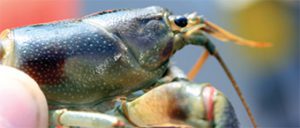
It is illegal to transport any crayfish species, dead or alive.
Photo: Doug Watkinson</span
Order: Decapoda
Family: Cambaridae
Rusty crayfish are large and aggressive, with adults reaching a body length of 7.5-13 cm (not including claws). They are native to the Ohio River Basin in the United States and were likely introduced by anglers from other areas discarding crayfish they were using as bait. They may also have been released into the wild by people who acquired them as pets or through the scientific supply trade. This aquatic invasive species gets its name from the rust-coloured patches that run down its sides; the rest of the body is gray/green to red/brown. While rusty crayfish look similar to native crayfish, they are distinguishable by the oval space between their closed claws and their pinched concave rostrum. Because of their size and aggressive feeding nature, rusty crayfish outcompete native species for food and space. They also damage fish populations by consuming aquatic vegetation needed for fish to spawn in and raise young. Females can carry up to 200 fertilized eggs under their tails, enabling a single female introduced to a new area to start a population. It is illegal to transport any crayfish species, dead or alive, and they can only be used for bait in the water in which they were caught.
How to identify rusty crayfish (Ontario Factsheet):
- Large adults can reach 7.5-13 cm rostrum (part of shell in front of eyes) to tail
- Rusty patches on each side of the shell
- Grayish-green to reddish-brown claws with black bands near the tips
- Claws have an oval gap when closed
- The rostrum is smooth, pinched, and distinctly concave
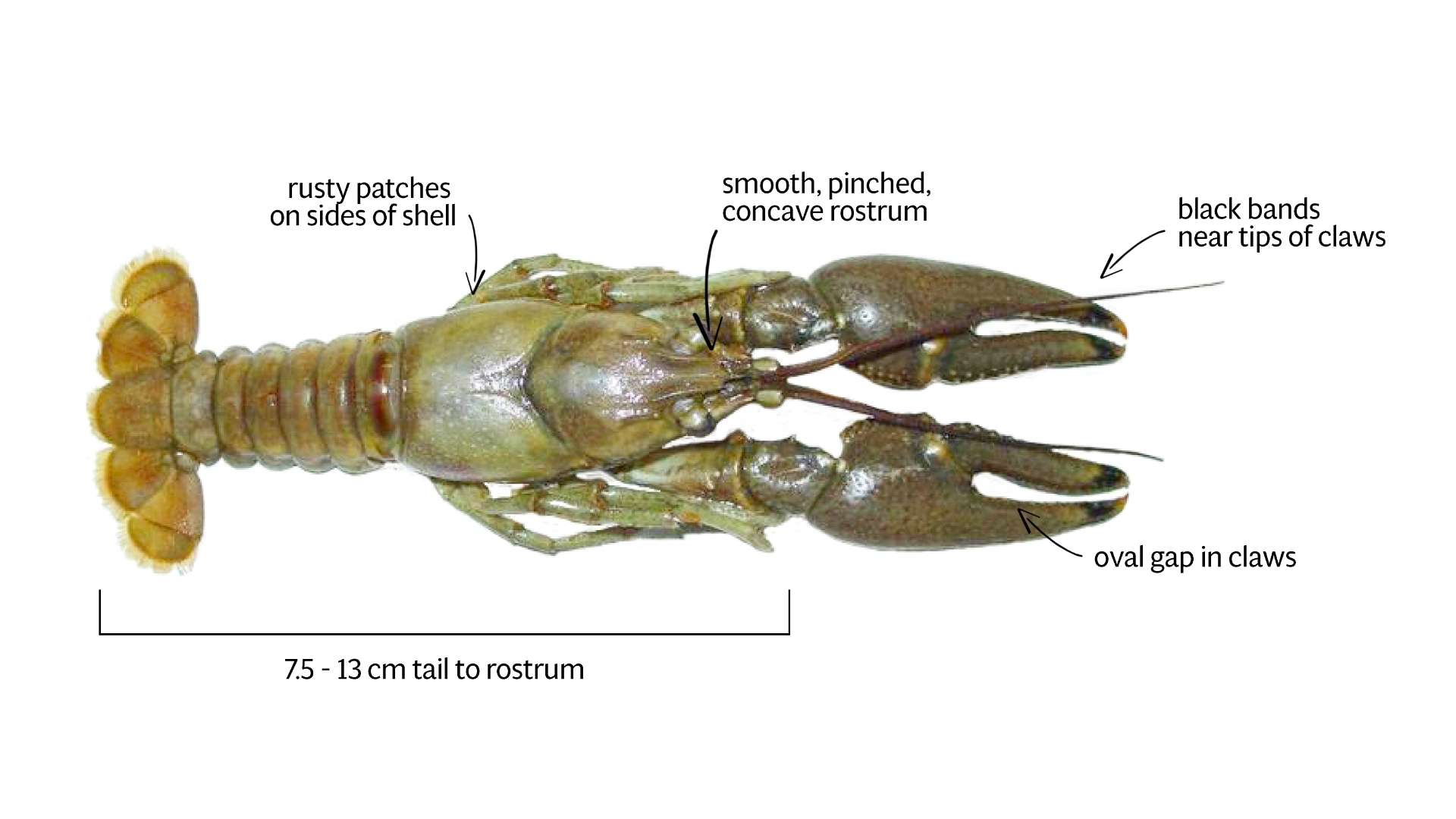
Rusty crayfish were first detected in Trout Lake, Vilas County, Wisconsin, in 1979 (Lodge et al. 1986) near a heavily used boat landing. It is suspected that this species was introduced to the lake sometime between 1973 and 1979 based on historical trapping data (Lodge et al. 1986).
Rusty crayfish are now found throughout much of south-central and southeastern Ontario, including Manitoulin Island, the Magnetawan River, the Kawartha Lakes Basin and the Ottawa River Basin, and in northwestern Ontario. Outside their native range in the Ohio River Basin, they have also spread to the midwestern and northeastern United States (Ontario Factsheet). They are commonly found in lakes, rivers, ponds and streams with clay, silt and gravel bottoms that contain rocks, logs or debris that they can hide under.
Rusty crayfish are strong interactors in many freshwater systems and, as a consequence, may have disproportionately large effects on invaded systems (Ontario Factsheet).
- Their large size, aggressive eating habits, and rapid spread have had serious impacts on native species.
- They compete with native crayfish for food and resources, often causing the decline or disappearance of native crayfish.
- They are better than native crayfish at avoiding being eaten by fish, increasing the likelihood that native species will decline.
- By eating large quantities of aquatic vegetation, they reduce spawning and nursery habitat for native fish.
- Female crayfish have the ability to carry fertilized eggs under their tail; this feature has allowed this species to spread rapidly.
Learn how to identify and prevent accidentally spreading this aquatic invasive species.
- If you want to use crayfish as bait, you may only use them in the waterbody in which they were caught. It is illegal to transport them over land. The maximum number of live crayfish you can have in your possession at one time is 36.
- If you have any information about the illegal importation, distribution or sale of rusty crayfish in Ontario, report it immediately to the Ontario Ministry of Natural Resources and Forestry TIPS line at 1-877-TIPS-MNR (847-7667) toll-free anytime, or contact your local Ministry of Natural Resources and Forestry office (ontario.ca/mnroffices) during regular business hours. You can also call Crime Stoppers anonymously at 1-800-222-TIPS (8477).
- If you’ve seen a rusty crayfish or other invasive species in the wild, please contact the toll free Invading Species Hotline at 1-800-563-7711, or visit www.eddmaps.com to report a sighting.
Fact Sheets
Best Management Practices

Lorem ipsum dolor sit amet, consectetur adipiscing elit. Ut elit tellus, luctus nec ullamcorper mattis, pulvinar dapibus leo.
Research
Environmental DNA (eDNA) detects the invasive rusty crayfish Orconectes rusticus at low abundances
species, yet many traditional sampling techniques are ineffective at the low population
abundances found at the onset of the invasion process. Environmental DNA (eDNA) is a …
Evolution of invasive traits in nonindigenous species: increased survival and faster growth in invasive populations of rusty crayfish (Orconectes rusticus)
understood, especially in animals. To evaluate evolution in crayfish invasions, we tested for
differences in growth rate, survival, and response to predators between native and invaded …
Effects of water velocity on the size and shape of rusty crayfish, Orconectes rusticus
morphology, and life history is widespread and can affect the ecology and evolution of
organisms. In streams, phenotypic plasticity in morphology and corresponding differences in …
Projects funded:
Further Reading
The Invasive Species Centre aims to connect stakeholders. The following information below link to resources that have been created by external organizations.

